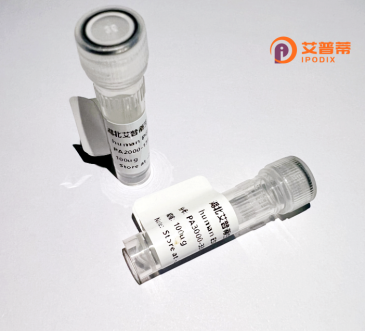
| 纯度 | >90%SDS-PAGE. |
| 种属 | Human |
| 靶点 | WASP |
| Uniprot No | P42768 |
| 内毒素 | < 0.01EU/μg |
| 表达宿主 | E.coli |
| 表达区间 | 2-502aa |
| 氨基酸序列 | SGGPMGGRPGGRGAPAVQQNIPSTLLQDHENQRLFEMLGRKCLTLATAVVQLYLALPPGAEHWTKEHCGAVCFVKDNPQKSYFIRLYGLQAGRLLWEQELYSQLVYSTPTPFFHTFAGDDCQAGLNFADEDEAQAFRALVQEKIQKRNQRQSGDRRQLPPPPTPANEERRGGLPPLPLHPGGDQGGPPVGPLSLGLATVDIQNPDITSSRYRGLPAPGPSPADKKRSGKKKISKADIGAPSGFKHVSHVGWDPQNGFDVNNLDPDLRSLFSRAGISEAQLTDAETSKLIYDFIEDQGGLEAVRQEMRRQEPLPPPPPPSRGGNQLPRPPIVGGNKGRSGPLPPVPLGIAPPPPTPRGPPPPGRGGPPPPPPPATGRSGPLPPPPPGAGGPPMPPPPPPPPPPPSSGNGPAPPPLPPALVPAGGLAPGGGRGALLDQIRQGIQLNKTPGAPESSALQPPPQSSEGLVGALMHVMQKRSRAIHSSDEGEDQAGDEDEDDEWDD |
| 预测分子量 | 53.6 kDa |
| 蛋白标签 | His tag N-Terminus |
| 缓冲液 | PBS, pH7.4, containing 0.01% SKL, 1mM DTT, 5% Trehalose and Proclin300. |
| 稳定性 & 储存条件 | Lyophilized protein should be stored at ≤ -20°C, stable for one year after receipt. Reconstituted protein solution can be stored at 2-8°C for 2-7 days. Aliquots of reconstituted samples are stable at ≤ -20°C for 3 months. |
| 复溶 | Always centrifuge tubes before opening.Do not mix by vortex or pipetting. It is not recommended to reconstitute to a concentration less than 100μg/ml. Dissolve the lyophilized protein in distilled water. Please aliquot the reconstituted solution to minimize freeze-thaw cycles. |
以下是关于WASP重组蛋白的3篇代表性文献:
1. **"Mechanism of regulation of WASP by the Cdc42 GTPase"**(作者:Kim et al., 2000)
*摘要*:通过重组WASP蛋白研究Cdc42如何激活WASP的构象变化,揭示了Cdc42结合诱导WASP的C端结构域暴露,从而促进其与Arp2/3复合体的相互作用,调控肌动蛋白聚合。
2. **"Reconstitution and analysis of the WASP-verprolin homology domain interactions"**(作者:Padrick et al., 2008)
*摘要*:利用重组WASP的VH结构域(WH1/WH2),解析其与肌动蛋白单体及信号蛋白(如PIP2)的结合机制,阐明其在细胞迁移中的分子基础。
3. **"Structural basis of WASP activation by the enterohaemorrhagic E. coli effector EspFU"**(作者:Cheng et al., 2008)
*摘要*:通过重组WASP蛋白的体外实验,证明细菌效应蛋白EspFU通过模拟天然配体(如Cdc42)直接激活WASP,触发宿主细胞肌动蛋白骨架重排,促进病原体感染。
4. **"N-WASP deficiency reveals distinct pathways for cell surface and nuclear actin polymerization"**(作者:Snapper et al., 2001)
*摘要*:通过重组N-WASP蛋白的功能回补实验,验证其在细胞膜变形(如内吞作用)中的关键作用,并揭示核内肌动蛋白聚合的独立调控机制。
以上研究均利用重组WASP蛋白阐明其结构、互作及疾病相关机制。
**Background of WASP Recombinant Protein**
The Wiskott-Aldrich syndrome protein (WASP), encoded by the *WAS* gene, is a critical regulator of actin cytoskeleton dynamics in hematopoietic cells. It is primarily expressed in immune cells, including T lymphocytes, B cells, and platelets. WASP functions as a scaffold protein, linking upstream signaling molecules (e.g., CDC42. PIP2) to the actin-nucleating Arp2/3 complex, thereby driving actin polymerization and cytoskeletal reorganization. This activity is essential for immune cell functions such as migration, phagocytosis, immune synapse formation, and intracellular signaling.
Mutations in the *WAS* gene lead to Wiskott-Aldrich syndrome (WAS), an X-linked immunodeficiency disorder characterized by thrombocytopenia, eczema, recurrent infections, and increased susceptibility to autoimmunity and malignancies. WAS-associated mutations disrupt WASP’s structural domains (e.g., WH1. GTPase-binding, VCA regions), impairing its interaction with binding partners or its ability to activate the Arp2/3 complex.
Recombinant WASP proteins are engineered to study its molecular mechanisms, disease-related mutations, and therapeutic interventions. These proteins are typically produced in expression systems (e.g., *E. coli*, insect cells) and purified for *in vitro* assays, structural studies, or drug screening. For example, recombinant WASP variants help elucidate how specific mutations alter protein stability, interactions (e.g., with WIP, SH3-domain proteins), or actin polymerization capacity.
Additionally, recombinant WASP serves as a tool to develop targeted therapies, such as gene therapy vectors or small molecules to restore WASP function in WAS patients. Its applications extend to modeling cytoskeletal defects in immune disorders and cancer, where dysregulated actin dynamics contribute to pathogenesis. Overall, WASP recombinant proteins bridge molecular insights into cytoskeletal regulation with translational research aimed at treating WAS and related immunodeficiencies.
×